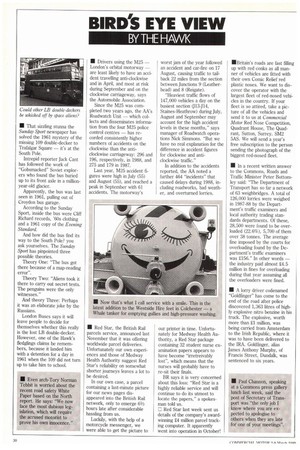BIRD'S EYE VIEW
Page 32

If you've noticed an error in this article please click here to report it so we can fix it.
BY THE HAWK
• That sizzling stunna the Sunday Sport newspaper has solved the 1961 mystery of the missing 109 double-decker to Trafalgar Square — it's at the South Pole.
Intrepid reporter Jack Cant has followed the work of "Gobsmacked" Soviet explorers who found the bus buried up to its front axle in a millionyear-old glacier.
Apparently, the bus was last seen in 1961, pulling out of Croydon bus garage.
According to the Sunday Sport, inside the bus were Cliff Richard records, '60s clothing and a 1961 copy of the Evening Standard.
And how did the bus find its way to the South Pole? you ask yourselves. The Sunday Sport has pinpointed three possible theories.
Theory One: "The bus got there because of a map-reading error".
Theory Two: "Aliens took it there to carry out secret tests. The penguins were the only witnesses."
And theory Three: Perhaps it was an elaborate joke by the Russians.
London Buses says it will leave people to decide for themselves whether this really is the lost LB double-decker. However, one of the Hawk's fledglings claims he remembers, because it landed him with a detention for a day in 1961 when the 109 did not turn up to take him to school. • Drivers using the M25 — London's orbital motorway — are least likely to have an accident travelling anti-clockwise and in April, and most at risk during September and on the clockwise carriageway, says the Automobile Association.
Since the M25 was completed two years ago, the AA's Roadwatch Unit — which collects and disseminates information from the four M25 police control centres — has recorded consistently higher numbers of accidents on the clockwise than the anticlockwise carriageway: 296 and 196, respectively, in 1988, and 275 and 179 in 1987.
Last year, M25 accident figures were high in July (55) and August (55), and reached a peak in September with 61 accidents_ The motorway's • Red Star, the British Rail parcels service, announced last November that it was offering worldwide parcel deliveries. Unfortunately our own experiences and those of Medway Health Authority suggest Red Star's reliability on somewhat shorter journeys leaves a lot to be desired.
In our own case, a parcel containing a last-minute picture for our news pages disappeared into the British Rail network, only to emerge 61/2 hours late after considerable hassling from us.
Luckily, with the help of a motorcycle messenger, we were able to get the picture to worst jam of the year followed an accident and car-fire on 17 August, causing traffic to tailback 22 miles from the section between Junctions 9 (Leatherhead) and 8 (Reigate).
"Heaviest traffic flows of 147,000 vehicles a day on the busiest section (J13-J14, Staines-Heathrow) during July, August and September may account for the high accident levels in these months," says manager of Roadwatch operations Nick Simmons. "But we have no real explanation for the difference in accident figures for clockwise and anticlockwise traffic."
In addition to the accidents reported, the AA noted a further 464 "incidents" that caused delays during 1988, including roadworks, bad weather, and overturned lorries.
our printer in time. Unfortunately for Medway Health Authority, a Red Star package containing 32 student nurse examination papers appears to have become "irretreivably lost", which means that the nurses will probably have to re-sit their finals.
BR says it is very concerned about this loss: "Red Star is a highly reliable service and will continue to do its utmost to locate the papers," a spokesman told us.
E Red Star last week sent us details of the company's awardwinning 24 million parcel tracking computer. It apparently went into operation in October! /Britain's roads are fast filling up with red conks as all manner of vehicles are fitted with their own Comic Relief red plastic noses. We want to discover the operator with the largest fleet of red-nosed vehicles in the country. If your fleet is so attired, take a picture of all the vehicles and send it to us at Commercial Motor Red Nose Competition, Quadrant House, The Quadrant, Sutton, Surrey. SM2 5AS. We will send a year's free subscription to the person sending the photograph of the biggest red-nosed fleet.
• In a recent written answer to the Commons, Roads and Traffic Minister Peter Bottomley said: "The Department of Transport has so far a network of 63 weighbridges. A total of 126,000 lorries were weighed in 1987-88 by the Department's traffic examiners and local authority trading standards departments. Of these, 28,500 were found to be overloaded (22.6%), 5,700 of them over 38 tonnes. The average fine imposed by the courts for overloading found by the Department's traffic examiners was £156." In other words — the industry paid almost £4.5 million in fines for overloading during that year assuming all the overloaders were fined.
• A lorry driver codenamed "Goldfinger" has come to the end of the road after police discovered 1,363 litres of highly explosive nitro benzine in his truck. The explosive, worth more than £1 million, was being carried from Amsterdam to the Irish Republic, where it was to have been delivered to the IRA. Goldfmger, alias James Anthony Murphy, of Francis Street, Dundalk, was sentenced to six years.




















































































































































